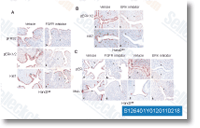To figure out distinct involvement of your ERK1 2 activation in SS RBC mem brane protein phosphorylation, each and every population of SS and AA RBCs was either treated or not treated having a potent MEK1 2 inhibitor, U0126, which specif ically inhibits ERK1 2 kinase activity. RBC membrane ghosts prepared from the resulting four populations of RBCs, were then either subsequently co incubated in the presence or absence of exogenous recombinant ac tive ERK2. Proteolytically digested mem brane fractions from every single of these eight exclusive samples have been then subjected to a previously described label absolutely free quantitative phosphoproteomics workflow utilizing re producible TiO2 phosphopeptide enrichments followed by selected ion chromatographic peak quantitation of accurate mass retention time aligned LC MS MS data to enable direct quantitative comparisons to become created across all therapy groups.
To minimize total analysis time, each and every sample was analyzed in analytical triplicate by a one dimensional LC MS MS analysis without having any added fractionation prior to TiO2 enrichment. Across all samples, 375 distinctive phosphopeptides corresponding to 155 phosphoproteins were identified at a peptide spectral hop over to this website false discovery price of 1. 0%. As localization of particular phosphorylated residues is essential for defining kinase distinct events, all phosphopeptides were subjected to ModLoc, a probability primarily based localization tool implemen ted within Rosetta Elucidator determined by the AScore algorithm. Approxi mately 74% of phosphorylated residues had Mod Loc scores above 15, and 66% had ModLoc scores above 20.
To assess the quantitative robustness of the label cost-free approach, the average technical coefficient of variation of retention time aligned phosphory lated peptide intensities of triplicate measurements within a therapy group had been calculated. i was reading this The imply %CV across all 375 phosphopeptides was 19. 8%, with 80% from the signals obtaining a %CVs much less than 27. 1%. The intensity on the phosphorylated peptide V173 R191 inside the ac tive site of ERK1 2 was applied to assess inter therapy group variation, which includes variation from TiO2 phospho peptide enrichment, as activated ERK2 was spiked in equal amounts to four of the eight samples. The typical %CV of this phosphopeptide inside any treatment group was 7. 0%, and across all ERK2 spiked samples was 18. 1%.
Constant using a majority of TiO2 enrichment primarily based worldwide mammalian phosphoproteomic studies, 79% on the identified phosphorylated residues had been localized to serines, 16% to threonines, and 5% to tyro sines, with an typical of 1. four phosphorylated residues per peptide. Gene ontology classification of the biological  function from the 155 identified phosphoproteins indicated nearly a third of your phosphoproteins were involved in binding as their primary biological function.
function from the 155 identified phosphoproteins indicated nearly a third of your phosphoproteins were involved in binding as their primary biological function.
Mirna Mimics
miRNA inhibitors for single or high throughput silencing
